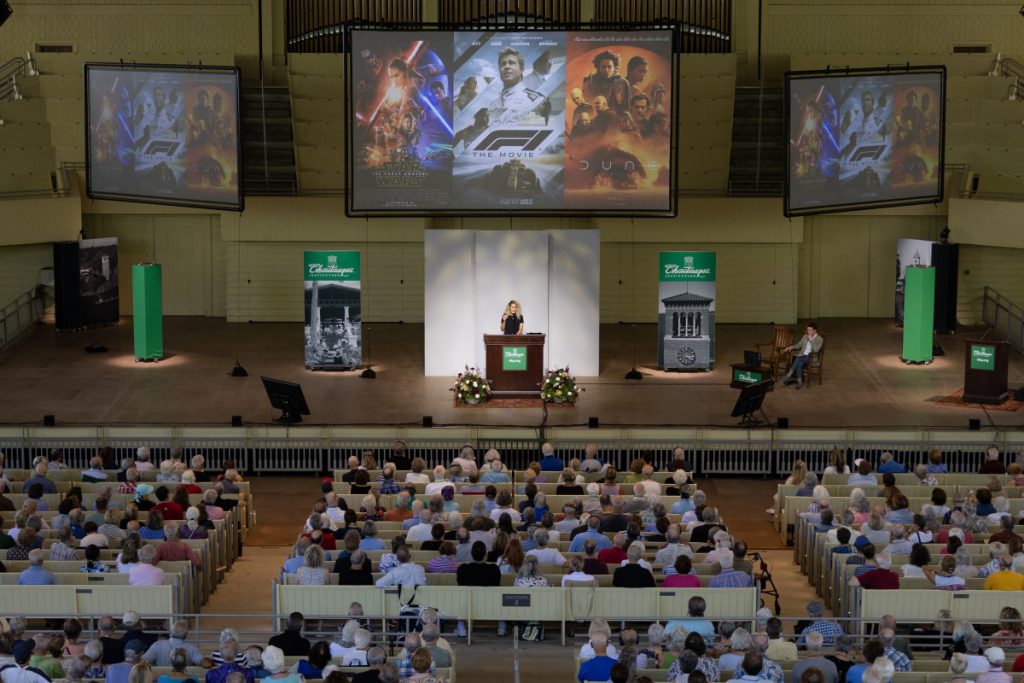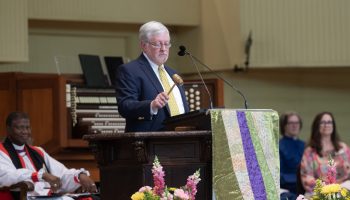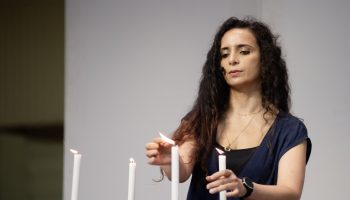
Julia Weber
Staff Writer
Drawing on her packed portfolio of combined scholarly and artistic practices, Suzi Mirgani delivered her morning lecture Thursday in the Amphitheater, exploring the role art and culture play in establishing geographic narratives in the
Middle East.
Mirgani is the editor and assistant director for publications at Georgetown University in Qatar’s Center for International and Regional Studies. Her academic work is widely published, and on top of that, she is a published short story writer and poet, and an award-winning filmmaker. She took to the Amp stage for the Week Eight Chautauqua Lecture Series theme, “The Middle East: The Gulf States’ Emerging Influence,” with a speech about her research on the intersection of Gulf Cooperation Council politics and cultural influence.
At the beginning of her lecture, Mirgani recounted an experience she had at an American supermarket. When the credit card machine offered the option to pay in Qatari Riyal or U.S. dollars, the cashier asked where she was from.
Mirgani recalled attempting to explain to the cashier that she was from Qatar in various ways — switching to an American accent, explaining its cultural significance with events like the World Cup and soccer. Still, the cashier didn’t recognize Qatar. Mirgani said it was where negotiations between the Taliban and Hamas had taken place — only to be looked at suspiciously.
“I gave up and I said ‘It’s next door to Dubai.’ Her face lit up. She was excited and she said it was on her bucket list. She said, in fact, she was saving up to go next year,” Mirgani said. “It’s this kind of casual conversation in an American supermarket that really made me wonder how the Gulf States brand themselves. It made me wonder how they want to be perceived internationally.”
In her lecture, Mirgani focused primarily on three states out of the six in the GCC: the United Arab Emirates, Qatar and Saudi Arabia.
“What I’m going to show you today are two very, very different sides of cultural production in these three states. The first is the official state narrative; this is what Gulf leaders want you to see. This is a conscious creation of national identity; this is the Gulf many of you know,” she said. “The second side of cultural production that I’m going to be talking about today is made by the Gulf citizens themselves. This is how artists and filmmakers represent their own nations; this is the Gulf many of you probably don’t know.”

Mirgani explained that what most Americans are most likely familiar with is the prominence of hydrocarbon-driven economies based on products like oil and gas.
“But natural resources, as we all know, are finite. The world knows this, Gulf leaders know this. The past two decades, we’ve heard one word over and over again, and that word is diversification,” Mirgani said. “We hear this word a lot. It’s really another way of saying ‘What do we do when the oil and gas run out?’ It’s really another way of saying ‘How do we transform oil and gas wealth into something else?’ ”
In an effort to diversify, Gulf States have shifted to culture-based economies as a more sustainable industry. Mirgani said American and European universities have established branch campuses in the Middle East and the worldwide sports industry has become heavily involved in the region, as well. The Middle East is also increasingly becoming home to arts and cultural establishments like museums and galleries, as well as popular places to film movies.
Mirgani said the 2000s brought turning points for the Gulf States in which a boom in oil and gas production — and, by extension, profits — led to an increase in cultural institutions and projects designed to “redisplay the Gulf States to
the world.”
“This was a culture with very clear economic and political purposes,” she said.
These places, which used to be a layover for individuals traveling elsewhere, have become destinations in and of themselves, with increased tourism demands as cities in the Gulf States have worked to brand themselves as cultural destinations.
For each city, Mirgani discussed the way the local government has branded itself to develop a specific, curated representation on the world stage.
Beginning with cities in the UAE such as Abu Dhabi and Dubai, Mirgani offered examples of how each city influences popular culture worldwide. For example, production companies are incentivized with monetary rewards to film portions of blockbuster movies in
the UAE.
Abu Dhabi has become a popular site for shooting film scenes because of these incentives. As a result, the city’s investments in its image are paying dividends, reaching mass
audiences worldwide.
“It’s not just that people around the world know Abu Dhabi, it’s how they know Abu Dhabi — as a wealthy country filled with fast cars, palaces and luxury,” Mirgani said. “A real-life fantasy.”
Meanwhile, Dubai, whose economy is based largely in trade finance and tourism as opposed to hydrocarbon, is increasingly focusing on popular and celebrity
culture.
“This is a culture that can be understood by people all around the world,” she said. “Sports stars, movie stars regularly make an appearance in the city in its five-star hotels, seven-star hotels and on its beaches.”
Mirgani said images of “outrageous wealth” are repeated again and again in marketing campaigns, portraying “carefree fun, entertainment, luxury, champagne, fast cars, desert landscapes, futuristic cities and, for some reason,
cheetahs.”
“Even though Dubai has built its reputation on decadent luxury, it still presents itself as an attainable popular culture,” she said. “It’s a once-in-a-lifetime holiday that an average American checkout lady dreams of. It’s a holiday you can
save up for.”
Qatar, on the other hand, “shies away from the splashy film productions and celebrities so loved by Dubai and Abu Dhabi.”
Mirgani, a Sudanese migrant residing in Qatar, explained the population of Qatar is roughly 90% migrants and 10% citizens.
She said the country’s first major international spectacle, the 2006 Asian Games, is also when the country’s first attempt at self-branding started to take form. In 2010, when it was announced that the 2022 FIFA World Cup would take place in Qatar, more infrastructure was built not only to meet the demands of the event, but to build the country’s reputation on the world stage as a cultural hub.
Among developments including a new football stadium, dozens of hotels, new roads, highways and airports was an increase in investment in educational and cultural infrastructure, like museums and similar
institutions.
As more tourists began to visit the region, leisure became a revenue stream and the country began differentiating itself as a cultural hub through souvenirs. Opting to shift away from the kitschy, mass-produced artifacts that can be found anywhere, state-funded arts institutions opted for more personalized,
intentional souvenirs.
“The souvenir identity crisis was finally addressed by Qatar museums,” she explained. “Now it makes unique products, now it makes products for Qatar. They’re not just created, they’re curated. In the tourism slogan ‘Curated for you,’ the state is speaking the language of museums.”
Mirgani said that while Dubai and Abu Dhabi have incentivized filmmakers to shoot on location in their cities, Qatar has opted to fund a more independent, refined genre of film to elevate the country’s brand.
“Like all other sectors, Qatar’s investment in cinema is geared toward elite audiences,” she said. “By supporting auteur filmmaking, Qatar aligns itself with a more refined idea of cinema rather than the popular blockbusters so loved by Dubai and Abu Dhabi.”
Qatar has invested in numerous companies and industries internationally across all sectors, which has come to be known as “Gulf entanglements,” according to Mirgani.
“Gulf money is so deeply and so inextricably linked to international corporations, to international brands, to real estate, to marketing,” she said.
Through these cultural developments in branding, Qatar has established itself as a cultural destination and “changed its
international reputation.”
Mirgani turned her attention to Saudi Arabia, “by far the most interesting and complex case of all the Gulf States.” Rebranding itself as a “modern, open and high-tech utopia,” she said the country has done much to change its reputation over the last few years. Mirgani pointed to the technological examples of Neom, a futuristic planned city startup, and Sophia, a hyperrealistic robot, as two examples.
Mirgani also discussed the advancements in women’s rights in Saudi Arabia, including the lifting of driving bans, dress codes and travel restrictions imposed upon women. Around the same time, the launch of the Red Sea International Film Festival brought major change to how women could be portrayed in films in
Saudi Arabia.
“Despite the many criticisms that can be and have been leveled at the Saudi state, women have benefitted from the social reforms,” she said. “Through seismic cultural transformations, women are now occupying central roles in this new national narrative.”
Mirgani cautioned that all of the information she had overviewed thus far in her lecture were the products of “state-sanctioned visions.” Independent artists, on the other hand, are engaging in different narratives surrounding their countries.
“What happens when a Gulf citizen — an ordinary Gulf citizen — makes a film or engages in a cultural production that speaks of their own country? How does this differ or how does this challenge the state narrative?” she asked. “Through film, we can begin to read the pulse of Gulf societies. Because neither citizens nor migrants have formal political participation, it is through the arts that ordinary people can advocate, critique and promote certain issues.”
Mirgani pointed out the paradox between the arts-led economies of the Gulf States and artists’ abilities to freely express themselves. She said the arts are a “relatively flexible space” and filmmaking in particular is “a medium in which we can discuss a wide array
of issues.”
By focusing on the human, as film does, individuals and cultures alike can gain a better sense of what citizens find important or how they feel about issues in their societies.
Mirgani presented a selection of films created by independent filmmakers in the Middle East as examples of counternarratives or ways of exploring sociopolitical issues. Many of the films she highlighted focus on social issues like the driving ban, sexual harassment and abuse, and interpersonal power dynamics.
“Even though the culture sectors are being instrumentalized by the governments for their own nation-branding efforts, the arts are also providing a very necessary space for social critique,” Mirgani said. “Gulf artists, as you have seen, are engaging in very rich and complex debates. This is the side of the Gulf you don’t normally encounter. It’s a space where ordinary citizens have a voice, where it can be heard. This is what the people of the Gulf want you to see and not just what Gulf governments want you to see.”




